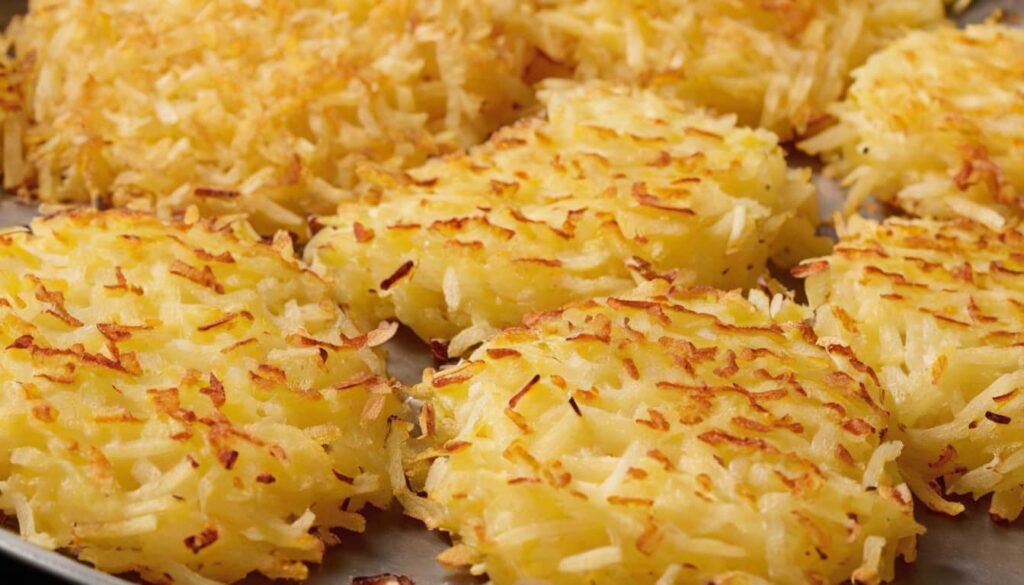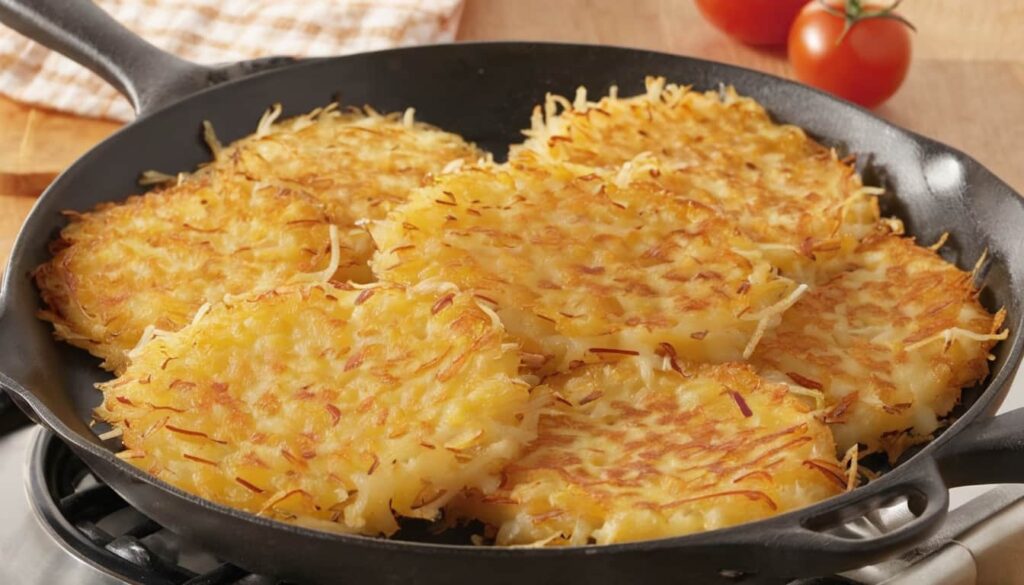Ultimate Crispy Hash Browns Recipe
Discover essential techniques for creating homemade hash browns that are flawlessly golden and crispy on the outside, yet tender on the inside. This guide provides insights and advice for mastering this popular breakfast side dish. Despite the challenges that might come with achieving the perfect texture and flavor, these tips ensure a delightful result every time. Ideal for enhancing any breakfast experience, this recipe is a must-try for hash brown enthusiasts and culinary adventurers alike.
After perfecting the Ultimate Crispy Hash Browns Recipe, you might enjoy trying another kitchen technique: making ghee in the oven, a simple yet transformative process for enhancing your cooking repertoire.
Choosing the Right Skillet for Perfect Hash Browns
Exploring the best skillet options for making hash browns reveals the unique advantages of using a cast iron skillet. While non-stick skillets can produce satisfactory results, cast iron stands out due to its exceptional heat retention and impact on oil usage.
For an optimal experience, a #8 cast iron skillet, measuring 9 inches at the base, is recommended. This skillet size pairs well with 2 ½ cups of shredded potatoes, a quantity refined through numerous trials to achieve the perfect balance. Too few potatoes can lead to burnt edges and uneven cooking, while an excess can result in undercooked, mushy centers. For larger batches, consider using multiple pans or preparing 2-3 batches consecutively. The following tips explain the rationale behind these specific portion sizes for this skillet dimension.
Ideal Seasonings for Enhancing Hash Browns

When it comes to selecting seasonings for hash browns, the classic combination of sea salt and black pepper often emerges as a top choice. Although additions like a sprinkle of garlic powder and paprika can be experimented with, they might slightly alter the authentic taste of hash browns. Similarly, incorporating diced or grated onion can introduce an appealing flavor, but it also deviates from the traditional pan-fried, slightly salty, and crisp potato taste. Additionally, onions introduce extra moisture, potentially affecting the cooking time and texture of the hash browns.
How to Achieve Golden Brown Perfection in Hash Browns
- Proper Potato Quantity in the Pan: The amount of potatoes affects the cooking process significantly. For instance, 2 ½ cups of potatoes in a 9″ pan is ideal. Ensure an even layer of shredded potatoes in any size pan, filling gaps and extending to the edges to create a uniform layer. Gently pressing the potatoes ensures they are evenly flat;
- Essential Steps: Rinsing and Drying Potatoes: Don’t overlook the importance of this step. After shredding, immerse the potatoes in cold water for a few minutes. Then, using a mesh strainer, strain and squeeze out as much water as possible, using your hands or a towel for assistance. Maximizing the removal of starch and moisture is crucial for achieving that perfect crispiness and golden hue. An alternative method involves rinsing the shredded potatoes under cold water in a strainer and stirring them for a few minutes, which is also effective in reducing moisture;
- Whether to Peel Potatoes: The decision to peel potatoes is up to personal preference. Peeling them often doesn’t noticeably affect the outcome. It’s recommended to retain as many nutrients as possible by leaving the peels on;
- Preferred Potato Shredding Technique: Utilizing the larger holes of a cheese grater is advised for ideal shredding. While some might own advanced food processors like the Cuisine-O-Matic, their shredder sizes may not be ideal for hash browns. Even with multiple attempts using a food processor, the results often don’t compare to those achieved with a basic cheese grater;
- Optimal Oil for Hash Browns: Olive oil is highly recommended for cooking hash browns. While butter might work in a non-stick skillet, olive oil is particularly effective in preventing sticking in cast iron pans and assists in flipping them easily;
- Incorporating Oil in Cooking: Use 1 tablespoon of olive oil to heat the pan and mix another tablespoon with the shredded potatoes before cooking. This method ensures even crisping throughout. Avoid using excessive oil, as it can saturate the bottom layer of the potatoes. Thus, judiciously dividing the two tablespoons of oil is crucial for the best results;
- Add Oil to the Edges Post-Flipping: Pouring a bit of oil around the edges after flipping the hash browns aids in crisping the edges. Some of the oil will seep down, coating the other side during cooking. While this might seem like a generous use of oil, the goal here is not to prioritize healthiness but to achieve maximum crispiness and flavor. Plus, using olive oil is a healthier option;
- Let the Potatoes Cook Undisturbed: Once the potatoes are in the pan and flattened, avoid disturbing them. If necessary, check after 12 minutes by gently lifting one edge with a spatula. If they stick, they aren’t ready yet. This applies to both sides; after flipping, wait until the 10-minute mark to check again;
- Understand Your Stove’s Quirks: Knowing how your stove operates is crucial. While it may not be top-of-the-line, being aware of its characteristics, like a burner that runs hotter, can affect cooking time and evenness. For instance, hash browns on a hotter burner might require 4-5 minutes less cooking time, though the results might not be as evenly cooked;
- Optimal Cooking Temperature for Hash Browns: The ideal temperature setting for cooking hash browns is lower compared to that for diced potatoes. On an electric range, setting the heat to around 2 ½, or a low-medium level, is recommended. This temperature range ensures even heating, cooking the hash browns thoroughly from the middle to the edges. Cooking on too high a heat can result in uneven browning and a soft center, altering the flavor. Conversely, a temperature that’s too low can significantly delay the cooking process and hinder achieving that desired caramel color. Maintaining a low-medium heat is key for optimal results;
- Deciding Whether to Cover the Pan: It is advisable to cover the pan during the initial cooking phase of the first side. This traps steam, helping the hash browns cook faster. Once flipped, remove the lid to let steam escape, which aids in achieving a well-grilled texture on the second side. By this stage, the middle should be fully cooked, allowing the focus to shift to browning the second side effectively.
The Best Oil for Frying Hash Browns
Choosing the Right Potatoes for Hash Browns
Russet potatoes are often considered the best choice for hash browns. They tend to hold their shape and texture better than softer varieties like Red potatoes and Yukon Gold. While these are the three commonly used types, there may be other varieties that could work well, but haven’t been widely tested in this context. Despite the potential of other types, Russet potatoes have proven to be consistently reliable and are a preferred option for making hash browns.
Portion Guide for Hash Browns
The recipe suggests that the portion yields 3 servings. However, this can vary as some might consume half or even the entire portion in one sitting. For a standard adult breakfast, it’s estimated that the recipe can comfortably serve three people.
Hash Browns Recipe

Discover the secrets to creating deliciously golden and crispy hash browns from scratch with this easy-to-follow recipe.
| Category | Details |
|---|---|
| Preparation Time | 5 minutes |
| Cooking Time | 30 minutes |
| Total Time | 35 minutes |
| Meal Type | Ideal for Breakfast, Suitable for Toddlers and Kids |
| Cuisine | American, Gluten-Free |
| Yield | 3 servings |
Ingredients:
- 2 ½ cups shredded russet potatoes (prepared post-soaking and drying);
- 2 tablespoons olive oil, divided (plus extra for drizzling);
- ¼ teaspoon sea salt;
- Freshly ground black pepper, to taste.
Instructions:
- Optionally peel the potatoes. Shred using the large holes of a cheese grater. Soak the shredded potatoes, then thoroughly drain and squeeze out excess liquid using hands or a mesh strainer with a paper or tea towel;
- In a bowl, mix the shredded potatoes with 1 tablespoon of olive oil, sea salt, and black pepper;
- Preheat a large (9-inch) skillet over low-medium heat (around level 2 ½) and add 1 tablespoon of olive oil;
- Place the potatoes in the skillet, pressing down to form an even layer. Cover and cook for approximately 20 minutes. Monitor the heat of your burner and consider checking the potatoes at 12-15 minutes, but it’s best to leave them undisturbed;
- Carefully flip the potatoes. Drizzle a little olive oil around the edges;
- For an easy flip, use a large plate to invert the hash browns, then slide them back into the skillet;
- Cook the second side uncovered for 8-10 minutes. Pressing down again is optional;
- Serve as desired – with salsa, hot sauce, ketchup, or enjoy them plain!
Conclusion
Preparing the ultimate crispy hash browns requires more than just a recipe; it’s about the mastery of a few techniques and the understanding of the ingredients. With the right skillet, quality olive oil, the correct quantity of well-prepared potatoes, and the ideal seasonings, you can recreate restaurant-quality hash browns right in your kitchen. It takes some practice to achieve the perfect balance between a crispy exterior and a soft interior, but once you master it, you’ll be able to serve up a scrumptious, satisfying breakfast staple that’s loved by everyone. Experiment with the tips and techniques shared, and you’ll soon discover your own signature hash brown recipe!
